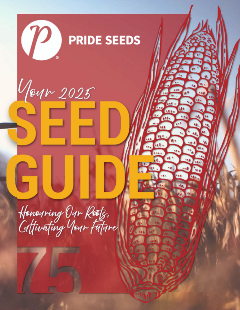WELCOME JEREMY O'SHEA TO PRIDE SEEDS

Enhance your knowledge and stay ahead with PRIDE SEEDS Corn and Soybean School videos.
Browse our selection of products below
___________________________________________________________________________________________________________________________________________

2024-2025 PRIDE Seeds Product GuideYou can find all of our products on the website, including supporting performance data and create your own personalized guide called My Guide. You can also download the digital version of our printed product guide which includes product comparison charts. |
SHOP THE PRIDE SEEDS E-STORE
-7.png?sfvrsn=87920db3_3)
STAY UP-TO-DATE WITH PRIDE SEEDS LATEST BLOGS, NEWS AND ARTICLES
Overcoming Late Corn Planting
Bad weather for an extended period can drastically delay planting. So, what’s a farmer to do once the optimal date for planting corn has passed? And just what does ‘optimal’ mean anyway?
Essentially, the optimal planting date is one that has been adapted by analyzing many years of data. It factors in average planting dates, harvest moistures (crop maturity) and grading factors that would define good test weight.
However, more than planting date, the growing season ahead is what truly defines the crop. A late start to 2017 in Southwestern Ontario tested growers’ patience and the average planting date was May 20. But, thanks to a great September and open fall, the crop was one of the largest ever, and was of very good quality.
The reality of later planting is that germination and emergence happen much more uniformly, and typically a hybrid requires ~10chu/day less to reach maturity as we get later into planting.

The above chart demonstrates average planting date and final provincial yield. Where yields have been maintained regardless of early seeding, there is not a strong correlation to planting date and final yield.
We must also consider factors such as, when will the earlier hybrid flower, and what adaptability it has to a farmer’s region. If the earlier hybrid is not adapted and cannot perform within 10% of the selected hybrid, growers are at greater risk of giving up $/acre returns.
OMAFRA pub811 recommends the following dates of when to consider the ‘switch’ based on maturity region:

And, when planters do roll, remember that early hybrids may have limited testing and may be less adapted to particular areas, which means it’s important to maintain seeding rates. Uniformity and rate of germination should be better once optimal conditions arrive. It is crucial to maintain seeding depth at no less than 1.75” and most importantly to plant ½” into moisture.
Here are some additional resources that support the need to maintain hybrid selection until closer to the end of May in order to maximize growing season and yield potential:
TAKE PRIDE IN YOUR INBOX
Expert advice, news and information
THE PRIDE SEEDS ADVANTAGE
Farming is one of the most demanding industries in the world, subject to a variety of factors such as time, weather, and global pressures. You know this every time you look out the window and think about the field in front of you. Growers and dealers deserve an advantage: The PRIDE Seed Advantage.
LEARN MORETHE PRIDE SEEDS ADVANTAGE
Every year PRIDE Seeds works hard to produce leading-edge products that enable success where it matters most, on your farm. Our dedicated team strives to provide sales expertise, agronomy support, quality production, and service tailored to meet your needs.
LEARN MORE

Leave a commentOrder by
Newest on top Oldest on top